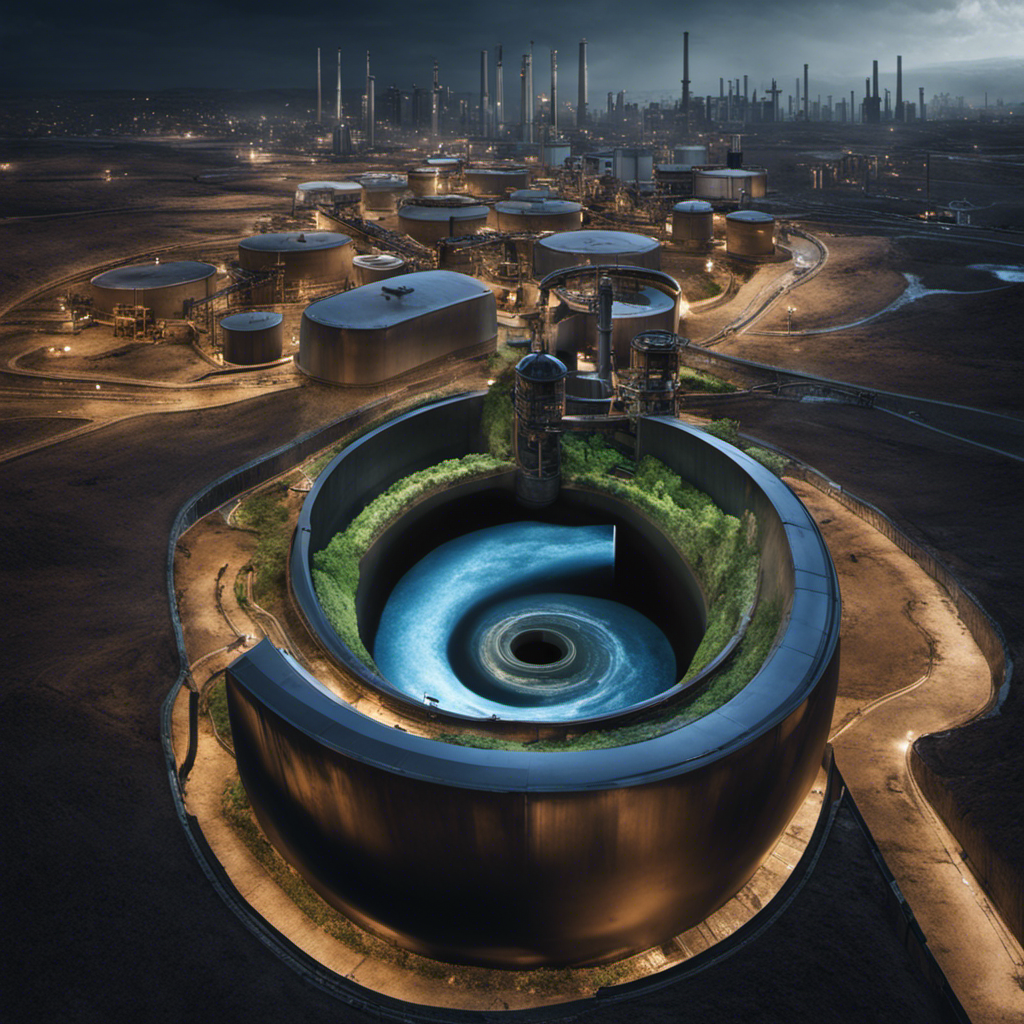When I flush the toilet, have you ever wondered where all that waste goes?
It’s a journey that begins in our homes and takes us into the intricate world of sewage systems and treatment plants.
In this article, we will delve into the fascinating process of wastewater management, exploring the environmental impact of flushing and offering tips for proper toilet waste management.
So, let’s dive in and uncover the hidden path of our flushed waste.
Key Takeaways
- Technological advancements in wastewater treatment have improved the quality of wastewater treatment.
- Improper sewage disposal methods can lead to water contamination and the spread of waterborne diseases.
- Treatment plants play a crucial role in effectively managing wastewater and preventing water source contamination.
- Flushing wastewater can have significant environmental consequences, and alternative technologies like waterless or low-flush toilets can reduce water consumption and environmental impact.
The Journey of Wastewater
When you flush the toilet, the wastewater travels through a series of pipes and treatment plants before being released back into the environment. This journey of wastewater is not just a simple process, but a complex system that involves various stages and technological advancements.
In recent years, there has been a growing focus on finding reuse opportunities for wastewater, driven by the need for sustainable water management. Technological advancements have played a crucial role in enabling the treatment of wastewater to a higher quality, making it suitable for various purposes such as irrigation, industrial processes, and even drinking water in some cases.
These advancements, including membrane filtration, UV disinfection, and advanced oxidation processes, have significantly improved the efficiency and effectiveness of wastewater treatment, opening up new possibilities for its reuse and reducing the strain on freshwater resources.
Understanding the Sewage System
The sewage system is responsible for transporting waste from our homes. It plays a crucial role in maintaining public health and preventing the spread of diseases. Understanding how sewage disposal methods work is essential for ensuring the effectiveness of this system. Here are some key points to consider:
-
Sewage disposal methods:
-
Conventional wastewater treatment plants
-
Septic systems
-
On-site sewage disposal systems
-
Advanced treatment technologies
-
Public health concerns:
-
Contamination of water sources
-
Spread of waterborne diseases
-
Environmental impacts
-
Proper maintenance and monitoring
Efficient wastewater management is essential for protecting human health and the environment. By implementing proper sewage disposal methods and addressing public health concerns, we can ensure the safe and sustainable management of our wastewater.
Treatment Plants and Their Role
Treatment plants play a crucial role in effectively managing wastewater and preventing the contamination of water sources. The wastewater treatment process involves several stages to remove physical, chemical, and biological pollutants from the wastewater.
Firstly, the wastewater goes through a preliminary treatment where large debris and solids are removed. Then, it undergoes primary treatment where sedimentation tanks are used to separate suspended solids. After that, secondary treatment is employed to remove organic matter and nutrients using biological processes. Finally, advanced treatment processes, such as disinfection, may be used to further purify the water before it is released into the environment or reused.
The benefits of wastewater treatment are numerous. It helps protect public health by reducing the risk of waterborne diseases, and it also safeguards the environment by preventing the pollution of water bodies. Additionally, treated wastewater can be reused for various purposes, conserving precious freshwater resources.
Transitioning into the next section on the environmental impact of flushing, it is important to understand how wastewater treatment plays a crucial role in mitigating the negative effects of flushing on the environment.
Environmental Impact of Flushing
Flushing wastewater can have significant environmental consequences. It is essential to consider the impact and implement effective wastewater treatment processes. The environmental impact of flushing is a topic that needs careful examination. This is especially true in light of the growing need for toilet water conservation and alternatives to flushing.
Here are some key points to consider:
-
Wastewater contains various pollutants, such as chemicals, pathogens, and nutrients. If not properly treated, these pollutants can harm aquatic ecosystems.
-
Traditional wastewater treatment plants use energy-intensive processes. These processes contribute to greenhouse gas emissions and overall environmental degradation.
-
Water scarcity is a pressing issue in many regions. Flushing toilets with clean, potable water is an inefficient use of a precious resource.
-
Alternative technologies, such as waterless or low-flush toilets, can significantly reduce water consumption and the environmental impact of flushing.
Tips for Proper Toilet Waste Management
Proper toilet waste management involves disposing of waste in a sanitary and responsible manner. When it comes to maintaining septic tanks, regular maintenance is essential to ensure their proper functioning.
Septic tanks should be pumped every 3-5 years to remove accumulated solids and prevent blockages. It is also important to avoid flushing non-biodegradable items such as baby wipes, sanitary napkins, and paper towels, as these can cause clogs and damage the septic system.
Another option for waste management is composting toilets. These toilets use a natural decomposition process to turn human waste into compost, which can then be safely used as fertilizer. Composting toilets are environmentally friendly and can be a great option for off-grid or eco-conscious individuals.
Frequently Asked Questions
How Does Flushing the Toilet Affect the Water Supply?
Flushing the toilet can affect the water supply by potentially causing water contamination. However, with proper wastewater treatment and conservation efforts, we can minimize these risks and ensure a sustainable water system for all.
Are There Any Health Risks Associated With Flushing the Toilet?
Flushing the toilet not only disposes of waste but also eliminates potential health risks. Proper toilet hygiene, such as washing hands after use, prevents the spread of germs and reduces the likelihood of contracting illnesses.
Can Wastewater From Toilets Be Reused for Any Purposes?
Wastewater from toilets can be reused for various purposes through effective water filtration systems. By implementing sustainable practices, we can harness the potential of this resource and contribute to a more environmentally conscious future.
How Does the Sewage System Handle Solid Waste?
The sewage system handles solid waste through a process called wastewater treatment. This involves separating the solid waste from the water and then disposing of it properly.
Are There Any Alternatives to Traditional Toilets That Are More Environmentally Friendly?
After researching alternatives to traditional toilets, I discovered composting and waterless toilets, which are more environmentally friendly. These toilets use innovative methods to break down waste without relying on water, reducing water consumption and promoting sustainable waste management.
Conclusion
In conclusion, the journey of wastewater after we flush the toilet is quite fascinating. It starts with the sewage system, which plays a crucial role in transporting the waste to treatment plants.
These treatment plants are designed to cleanse the wastewater and remove harmful substances, ensuring a cleaner environment. However, it is essential for individuals to practice proper toilet waste management to minimize the environmental impact.
By understanding the scientific and analytical aspects of this process, we can contribute to a healthier and more sustainable future.










